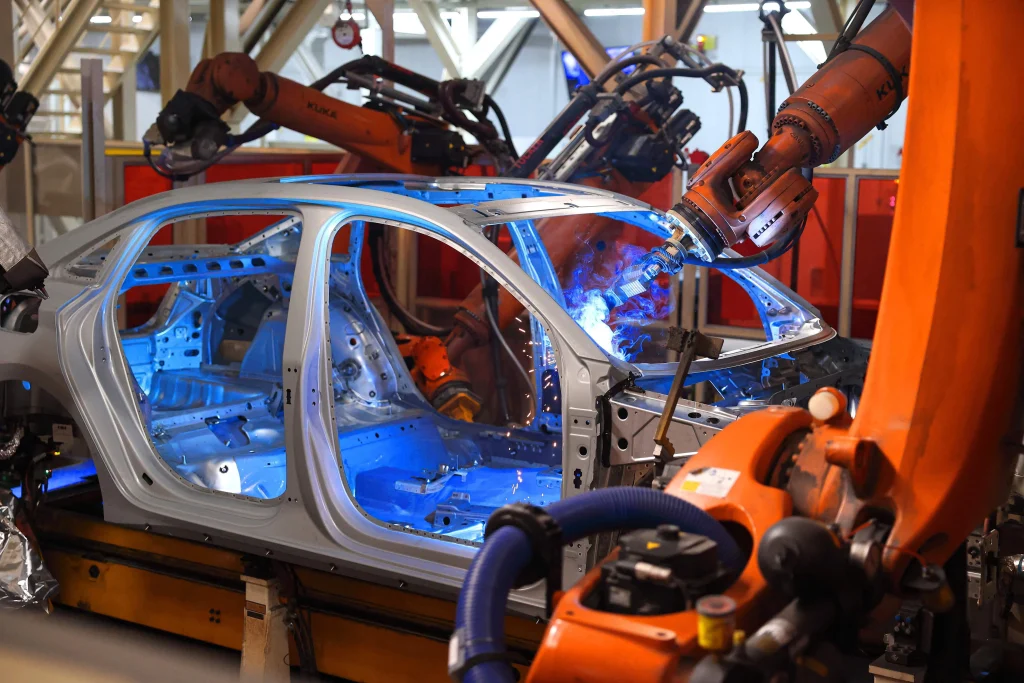[SINGAPORE] As the US and China race to dominate artificial intelligence (AI), Beijing’s industrial-first approach is quietly redrawing Asia’s tech landscape, opening doors for Asean manufacturers and shifting the region’s centre of gravity.
At Insead’s AI Forum Asia last week, economists said China’s focus on applying AI to real-world sectors like precision engineering and healthcare, rather than chasing software dominance, could accelerate tech transfer to South-east Asia, especially as geopolitical rifts deepen.
Since launching its “Made in China 2025” strategy, Beijing has used AI to push its manufacturing sector up the value chain, lifting industries like electric vehicles and solar energy in the process, said Dr Pushan Dutt, professor of economics and political science at Insead.
Dr Dutt explained that China’s approach stands in contrast to US tech companies, who have prioritised a push towards software supremacy through a strong talent pool and widespread implementation across business needs.
For instance, Dr Dutt added that 40 notable AI models in the last ten years had been developed in the United States, more than double of the 15 models developed in China.
In addition, AI infrastructure in the US remains far stronger than in China, with ten times more data centres and four times more spending on AI servers. “Yet 70 per cent of patents in the AI sector are coming from China,” Dr Dutt noted.
A NEWSLETTER FOR YOU

Friday, 8.30 am
Asean Business
Business insights centering on South-east Asia’s fast-growing economies.
“China is much more pragmatic in solving social problems such as manufacturing and healthcare, whereas the Americans have spent more time on knowledge diffusion,” he said.
The Asian giant’s acceleration of its AI ecosystem is as much a response to external pressure as it is an internal strategy, Dr Dutt explained. He noted that rising US export controls on semiconductors and advanced computing tools have only pushed China to innovate more aggressively.
Natural partners
In addition, US trade policies under US President Donald Trump could change the way AI technology spreads geographically. “Trump’s policies could also trigger China to build its own alliances within its sphere of influence, which might mean exporting more of its technologies to Asia and the Middle East,” said Dr Lily Fang, professor of finance and dean of research and innovation at Insead.
One of the regions that stands to benefit directly from this realignment is Asean, Dr Fang told The Business Times. South-east Asia’s strong manufacturing base makes it a natural partner for Chinese AI solutions, particularly in areas such as precision engineering and industrial robotics.
While leading US models such as Open AI’s GPT-4 and Anthropic’s Claude remain closed source, Chinese AI developers have lowered barriers towards more widespread cross-border adoption, Dr Fang noted. DeepSeek, for instance, has released its model weights, source code and documented its training methodologies.
“These countries will be competitive because they have both the hardware and software capabilities,” Dr Fang added.
Evolving infrastructure
South-east Asia’s infrastructural capabilities for AI, such as energy and data centres, have also made the region increasingly attractive to Chinese firms as domestic supply reaches bottlenecks.
Still, the region’s AI capabilities have not developed on equal footings, said Kevin Pereira, managing director at the AI consulting firm BluAI. “There are big differences in infrastructure across South-east Asia,” he noted. “If you don’t have good infrastructure, no matter how good the individual products are, using AI becomes really difficult.”
For Asean countries to capitalise on their strengths, these economies will need to evolve with the times, Dr Fang said. “For South-east Asia, perhaps the most important step is to upskill the workforce beyond lower-end manufacturing,” she said.
Such upgrading does not necessarily mean widespread loss of jobs in manufacturing, Dr Fang noted. “For example, tasks that rely on the dexterity of human fingers will not be replaced by robotics,” she said. “But certain tasks that may be dangerous, tiring or repetitive can be done by robots instead, allowing humans to focus on more meaningful tasks.”
The need to upskill was echoed by the forum’s keynote speaker Andrea Phua, senior director at the Ministry of Digital Development and Information’s digital economy office and lead author of Singapore’s AI strategy that was launched in 2023.
While Asean’s lower-end manufacturing jobs are likely to witness meaningful development, Phua noted that white collar jobs across several sectors would likely experience significant disruption. “AI is transforming the newsroom, the courtroom, the factory floor and laboratories,” said Phua.
“The shifting of value chains will be a painful conversation that requires a hard look,” cautioned Phua. “On top of technological innovation, business leaders will have to introduce organisational and bureaucratic innovation to keep moving forward,” she added.
She noted that while optimism towards AI technology is not misplaced, the speed of change demands a mindset shift across the labour force.
“When AI development moves at the pace that it does, our learning needs to happen in weeks, not even months,” she said.


